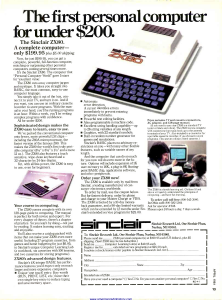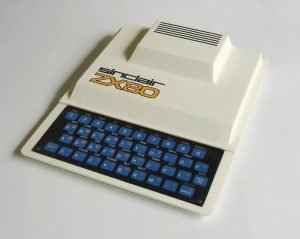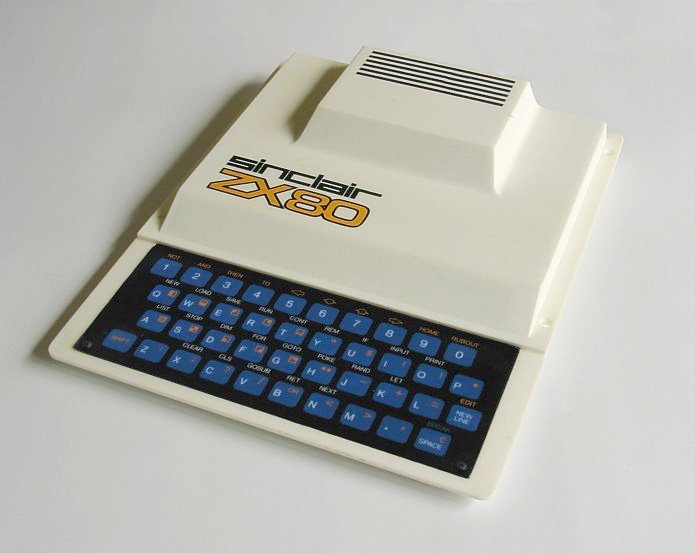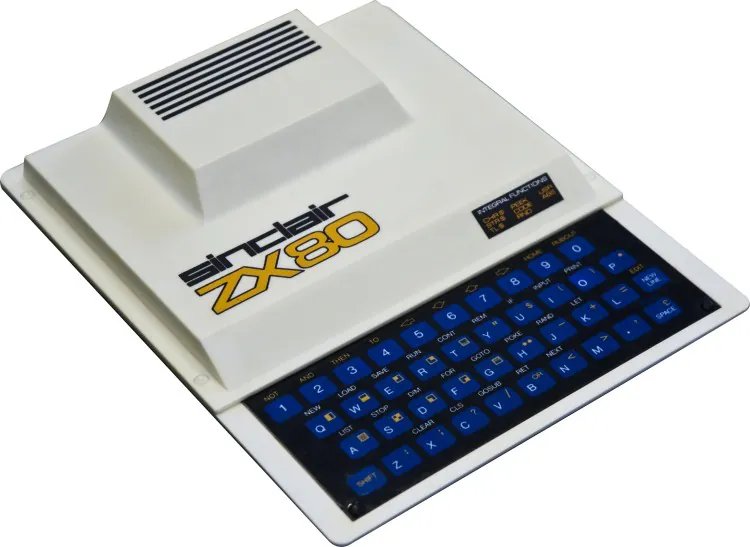
The ZX80 was Sinclair’s first computer sold in the United States. Launched in June 1980, the ZX80 was notable for its size, weight and price. At 7″ x 9″, weighing less than a pound and priced at $199.50, it was the smallest, lightest and least expensive home computer available at the time.
The ZX80 was named after the Z80 processor with the ‘X’ meaning “the mystery ingredient.” Sinclair retained the ZX prefix for subsequent computers up to the QL.
It featured 1K of RAM, a 4K ROM that contained a limited version of BASIC and it connected to the owner’s TV for display. Like many other home computers available then, it used cassette tape for storage.
The ZX80 was designed around readily available and inexpensive TTL integrated circuits (“chips”). The only proprietary technology was the firmware.
Sinclair cut costs by using an inexpensive case and a flat, membrane keyboard. The individual keys were etched on the circuit board and covered by a thin, conductive membrane printed with the key symbols.
BASIC
The majority of home computers available in 1980 contained a BASIC interpreter in ROM. In most of those computers, the BASIC ROM was at least 8K (8,192 bytes) in size and supported most of the features of Dartmouth BASIC they were based on.
An 8K BASIC interpreter was the base level against which other systems were measured. An “extended” BASIC might be in a larger, 16K ROM or load from disk, for example.
By contrast, the original ZX80 BASIC was contained in a 4K ROM. It was impossible to include the entire BASIC keyword and feature set and the ZX80 BASIC was a subset of the standard.
Sinclair saved ROM space by upending how BASIC programs were entered. Instead of typing out the full keyword, most Sinclair BASIC keywords were entered via a single keystroke (or with a shift key). Entering “PRINT”, for instance, required only a press of the O key.
Only six functions were entered manually: they were listed on a small sticker on the front of the computer.
Space saving efforts resulted in other shortcomings in Sinclair BASIC, including:
- Lack of support for named files. Users merely “SAVEd” or “LOADed” the next program on the tape. File management was entirely up to the user.
- Some features in other BASICs, most notably READ, DATA and RESTORE, were missing from Sinclair BASIC.
- Numeric variables were limited to integer values from -32768 to 32767.
- Only 26 string variables (A$ to Z$) were available.
- Line numbers were limited to 1 to 9999.
- Statements were limited to one per line number.
On the other hand, Sinclair BASIC had dynamic syntax checking. The ZX80 would check the program line as the user entered it and it would not let users enter invalid program code.
Video Display
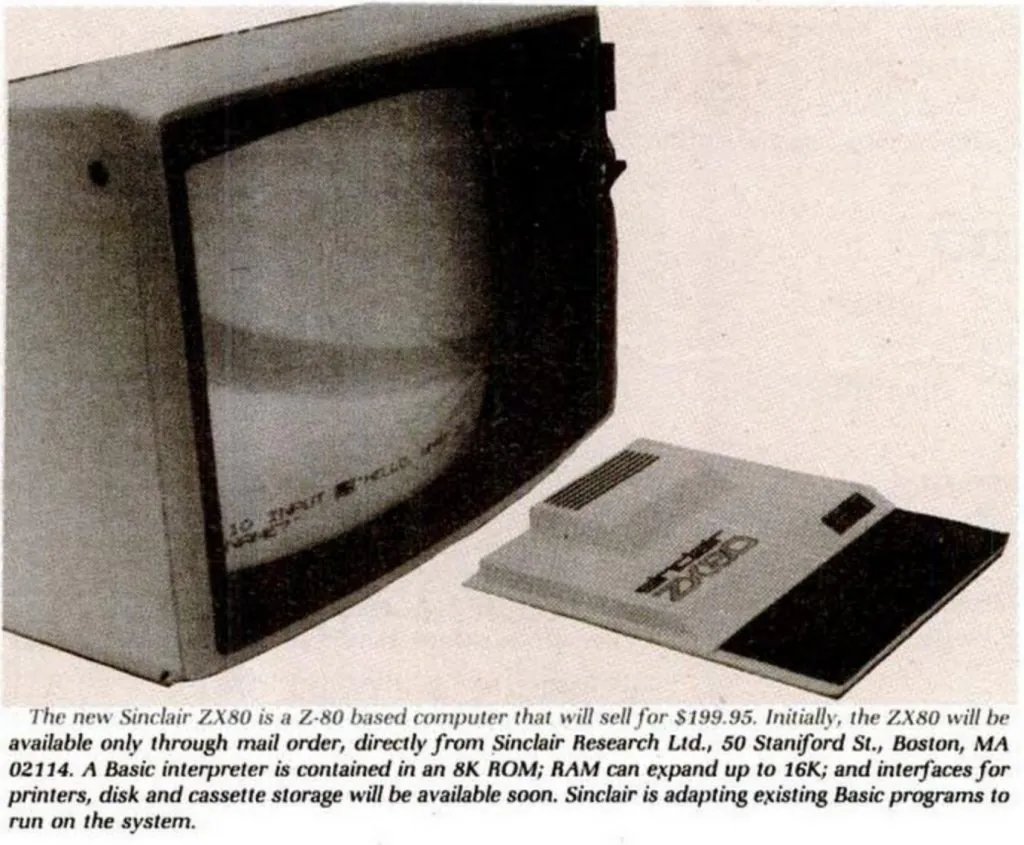
The ZX80 display was equally unconventional. Instead of a full-screen of code where any line could be edited at will, the ZX80 display was divided in to an upper area of 32 characters across by 22 lines down. A lower section, of two lines, was the “input area” where users enter program lines or responded to input prompts from the computer.
The ZX80 was limited to upper case letters and the organization of characters was not compatible with ASCII, the industry standard. Special block characters and their inverse (reverse video) allowed users to make relatively low resolution graphic displays.
Video signal generation was one most notable trade-offs. While the central processor unit (CPU) ran at approximately twice speed as other Z80-based computers, it also generated the video signal. The CPU paused the video signal when performing computing tasks, resulting in the TV picture disappearing. Running a program or pressing a key caused the screen to blank.
This made moving graphics difficult since the programmer had to pause the program so the computer could update and turn on the display. Softsync’s Super ZX80 Invasion, released in early 1981, was one program that overcame this shortcoming.
The computer’s RAM stored the screen display. As a result, the available screen size would decrease as the size of a program increased (and vice versa). With 1 KB RAM, a 990 byte program would result in only one row of characters being visible on the screen. At the other end, a full screen (32×24) would leave only 384 bytes to the programmer.
Expansion
Other than the built-in cassette and video ports, the only means of expansion was a slot opening at the rear of the case, which exposed an expansion bus edge connector on the motherboard. The original Sinclair ZX80 RAM pack held either 1, 2 or 3KB of static RAM and a later model provided 16KB RAM.
Sinclair announced an 8KB ROM to upgrade the ZX80 at a cost of around 20% of a ZX81. While it was not actually available until after the ZX81 launched, it was popular with ZX80 owners.
The new ROM came with a thin keyboard overlay and a ZX81 manual. Users opened their ZX80, pried the old ROM from its socket and inserting the new ROM and replacing the keyboard overlay. The new ROM did not have the ZX81’s SLOW mode: it required hardware not in the ZX80. Several companies made upgrades to address even that shortcoming.
Because tapes were not compatible between the two ROMs, some enterprising users build special circuits to allow them to easily switch between the two.
Hobbyists also attached full-size keyboards to their ZX80s, even moving the motherboard into a larger case. This had the dual advantages of making the machine easier to type on, while increasing ventilation to the motherboard.
Reception
The ZX80 was widely advertised as the first personal computer for under £100 (US $200).
The first mention of the ZX80 in the US was in the January 31, 1980 edition of the Wall Street Journal, which announced that the computer would “be marketed by the company’s Boston office in a few months.”
The Wall Street Journal article noted the unique physical attributes and price of the computer, which was less than half of other personal computers. Sinclair estimated that 20,000 – 30,000 personal computers were sold a month.
Sinclair formally introduced the ZX80 at the 1980 Summer Consumer Electronics Show in Chicago. Creative Computing and Infoworld were among several specialty magazines to highlight the computer in their coverage of the event.
By November 1980, Syntax ZX80, a newsletter dedicated just to the ZX80, launched. SYNC magazine, also dedicated to the ZX80, appeared in January 1981.
Reviews of the computer appeared in popular computing magazines as early as December 1980.
Kilobaud Microcomputing liked the design of the preassembled version, and said that the screen flickering during input or output was annoying but was useful as an indicator of the computer functioning correctly. It praised the documentation as excellent for novices, and noted that purchasing the computer was cheaper than taking a college class on BASIC. The magazine concluded the “ZX-80 is a real computer and an excellent value,” but only for beginners who could learn from the documentation or programmers experienced with writing Z-80 software.
BYTE called the ZX80 a “remarkable device.” It praised the real-time, interactive BASIC syntax checking, and reported that the computer performed better on benchmarks than some competitors, including the TRS-80 Model I. The screen blanking during program execution, small RAM size and inadequate built-in Sinclair BASIC, and the keyboard received criticism, and the review recommended against buying the kit version of the computer given the difficulty of assembly and because purchasers did not save money. BYTE concluded that “the ZX80 might be summarized as a high-performance, very low-cost, portable personal computer system … the ZX80 is a good starting point.”
Sales
Almost all ZX80s were sold by mail order: Sinclair did not have a distribution network in the United States. Potential owners read about the ZX80 in magazines and ordered it without having seen it in person.
At the time, it was not unusual for computer and electronics hobbyists to purchase products via mail order. Most cities did not have computer stores and those that did sold systems that cost thousands of dollars. Radio Shack stores brought their computers to many cities and smaller towns but even the least expensive TRS-80 was more than twice the cost of the ZX80.
Advertisements for the ZX80 started to appear in popular computing magazines in the fall of 1980. Among other things, the ads mentioned that tens of thousands had sold in Europe. Nigel Searle, a Sinclair representative, mentioned world-wide sales had exceeded 50,000 at a user group meeting in December 1980.
By March 1981, Infoworld called them the “third major competitor in the personal-computer industry.”
The New York Times reported that Sinclair was producing 10,000 ZX80s a month in April 1981, third in volume behind Apple and Radio Shack.
An article in The Guardian noted that 30,000 units has been sold in the US alone by July 1981.
References
- “U.K. Firm Bringing Out Small, Low-Priced Microcomputer.” The Wall Street Journal, January 31, 1980, sec. J.
- “World’s Lowest-Priced Computer.” Infoworld, March 2, 1980.
- Ahl, David. “Random Ramblings: The Consumer Electronics Show.” Creative Computing, September 1980.
- Ahl, David. “Random Ramblings: The British Scene.” Creative Computing, November 1980.
- Tebbutt, David. “Sinclair ZX80.” Creative Computing, December 1980.
- Thornburg, David, and Betty Burr. “Computers and Society.” Compute!, October 1980.
- Craig, John. “New Consumer Computers Premiere at CES.” Infoworld, August 4, 1980.
